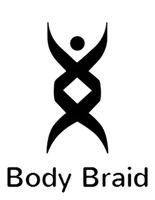LEARN MORE
The Body Braid increases your ability to sense your body.
Wearing the Body Braid creates a gentle pressure on your skin, and this pressure creates a link between your movement and the stimulation of your sensory nerves. Your brain receives enhanced information about where your body parts are, and how they are moving relative to each other.
The Body Braid’s effect is similar to that of turning up the volume of a hearing aid, which helps your sense of hearing, or putting on a pair of glasses, which help your sense of seeing. Putting on a Body Braid amplifies your sense of coordination and posture, also known as proprioception or kinaesthetic awareness.
The Body Braid can inform your posture at a subconscious level of awareness, which means it can influence your movement and posture even when you aren't thinking about it.
The Body Braid increases enjoyment of the feelings you have in your body.
It feels great to wear a Body Braid because the right balance of support and challenge inspires playful movement for the pure joy of it.
We’ve seen this effect when we watch people put on a Body Braid for the first time. Athletes sense new power and want to leap onto the court. Walkers feel the spring in their step and want to head out the door. Dancers feel an urge to move to the groove. Yogis sense a deepening of their practice with an enhanced connection between mind and body. Whatever you love doing with your body, or whatever you must do with your body, the Body Braid can help you feel better doing it. Even if you are sitting and reading, it can help you sit up and pay better attention.
But how does it work? Why does being braided in a spiralling elastic band feel so good?
The Body Braid enhances elasticity.
The Body Braid’s stretchy material acts like fascia, which are bands of elastic fibre running through your body. A vital element in your ability to move well, fascial tissue is a web of connective tissue that runs through all your muscles, tendons, ligaments and joints.
When we are young, our fascial tissue is very elastic. But with age and trauma, the bouncy elastic tissue is replaced by stiffer, more fibrous tissue. The elastic of the Body Braid mimics the elastic bounce of youthful tissue, which explains why people often enjoy playful jiggling movement when they put on the Body Braid.
The elasticity of the band’s rebound may help improve physical performance. It takes work each time you stretch out the material, but the energy comes back to you as a boost of support in the rebound. For your legs, the stretch is pulled down by gravity so the bounce back up is bonus energy.
The Body Braid links disconnected body parts into an integrated system.
The Body Braid’s spiraling lines are based on a pattern of spiraling fascial lines that occur naturally in your body. Identified by the bodywork expert Thomas Myers, these spiraling lines inspired Body Braid inventor Blair Voyvodic’s vision for the Body Braid.
In his book Anatomy Trains, Myers describes how body-wide fascial connections, which he likens to train cars lined up on a track, influence posture and movement patterns.
These fascial train lines are bands of fascial tissue that link your body parts into a whole. When your anatomy trains are working well, moving your toe may result in ripples of movement throughout your body.
But, with age, and especially with scarring from injuries, your anatomy trains can become glued down. Instead of moving in whole-body patterns, your body parts can become segregated, each functioning separately and with isolated effort.
Just as healthy fascial tissue links the many parts of the body, so does the continuous fabric of the Body Braid unite the parts of the body into a networked system. The body can once again work as an integrated whole, rather than as a collection of isolated parts.

image: The Spiral Line, one of the Anatomy Trains myofascial meridians.
More reference links:
Frey Faust's work on Axis Syllabus, as taught by Ruth Douthwright, has been key to the development of the Body Braid system.
Dr. Mark Driscoll is a Biomechanical Engineer at McGill University and has written an excellent article on the importance of fascia, especially our low back fascia. To read his article click here.
For a detailed article on the emerging field of Biotensegrity and elastic undulations, click here.
To learn more about how the Body Braid helps with hypermobility, especially in the severe form of Ehlers Danlos, click here.
The Body Braid lifts body and mood
Our mood is affected by our posture and poise. If you have ever noticed how collapsing into a slouch goes along with feeling down, or how good it feels when your body lightens up with excitement, that is the link between body and mood. Wearing the Body Braid retrains movement to be aligned and balanced. This gentle cue to move upright can lift both body and mood.
The Body Braid’s effect lingers
While you are wearing it, your body is reminded of what well-aligned, coordinated movement feels like. And even after you remove the Body Braid, your body remembers. Each time you go back and forth between wearing the Body Braid and then noticing the feeling when you take it off, you are training your nervous system to give more attention to the internal signals of upright posture and coordinated movement. People generally like wearing the Body Braid tight at first to get strong signally. Over time, you get the benefit with looser and looser fitting. You can set the sizing to give a "whisper" of postural cueing that you can wear all day.
